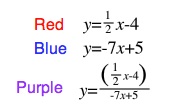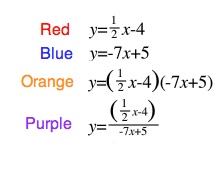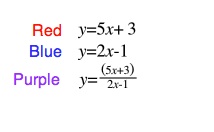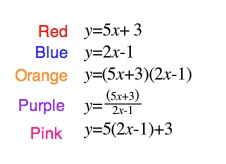

Assignment #1
Operations with Functions
by
Angela Wall
Make up linear functions f(x) and g(x). Explore, with different pairs of f(x) and g(x) the graphs for
i. h(x) = f(x) + g(x)
ii. h(x) = f(x).g(x)
iii. h(x) = f(x)/g(x)
iv. h(x) = f(g(x))
Summarize and illustrate.
The first pair of linear functions explored was f(x) = 1/2x - 4 and g(x) = -7x + 5. When comparing the graphs of the two linear functions with the graphs of the functions made by the four different operations with the linear functions, it was interesting to note how algebraic manipulations of functions can manipulate the graphs of the original functions and how certain algebraic outcomes can be connected to certain graphical outcomes.


The first operation with the two linear functions, h(x) = f(x) + g(x), involves adding one linear equation to another linear equation. Since the operation is addition, the exponential power of the variable does not change. As a result, h(x) is also a linear function.


The second operation with the two linear functions, h(x) = f(x)*g(x), involves multiplying the two functions. The highest exponential power of the variable becomes 2, therefore resulting in a quadratic equation. The graph of the function of h(x) takes the shape of a parabola, intersecting the two linear equation equations a total of four times. Two of the points of intersection also intersect the x-axis. These points of intersection indicate the zeros of the quadratic function, h(x). With the graph of the two linear functions and their product, it helps visualize how the roots, or zeros, of a quadratic function relates to its linear factors. An exploration like this could help students visualize what they are doing when solving quadratic equations.


When the two linear equations are divided, a rational function is formed, having a vertical asymptote at x = 5/7 (≈.714) and a horizontal asymptote at x = -1/14 (≈-.0714). When comparing the rational function to the two linear functions, the graphs of one of the linear functions and the quotient of the linear functions cross the x-axis at the same place, therefore having the same zero. This makes sense because the particular linear function is the numerator of the quotient function. When that particular linear function and the rational function are set equal to zero, they both result in the same x value.


The asymptotes can be found in various ways. For non-Calculus students, a table of values for the function could be explored for x values that approach some value (see tables below). Notice in the tables below, that as x approaches 5/7, the value for y approaches positive and negative infinity, meaning the vertical asymptote is at 5/7. As x approaches positive and negative infinity, y approaches -1/14, meaning the horizontal asymptote is at -1/14.
The vertical asymptote cand also be found by taking the denominator of the rational function, setting it equal to zero, and then solving for x. This x value is the value for the vertical asymptote. A discussion of why setting the denominator equal to zero in order to find the value for the vertical asymptote would be good for students to see the connection between properties of a function and its graph. For Calculus students, the asymptotes can be found by finding the limit of the function as x approaches a certain value. L'Hôpital's rule could be use to find the value for the horizontal asymptote.


The composition of the two linear functions, h(x) = f(g(x)), resulted in another linear function since the function g(x) was only multiplied by a constant and not another variable. Having a different slope as f(x) and g(x), h(x) intersected both of the original two linear functions. Since g(x) = -7x + 5 was multiplied by the fraction 1/2, the slope of the composition function was not as steep as the slope of the function g(x).


When the product and quotient functions are both graphed, along with original linear functions, the graphs of the product and quotient functions intersect the line f(x) = 1/2x - 4 at the same point, (5/7, -51/14). It is somewhat intuitive of why the quadratic and rational functions have the same point of intersection. When the rational function is set equal to f(x), solving the equation just requires one step before getting the same equation as when the quadratic equation is set equal to f(x).


The second pair of linear functions explored was f(x) = 5x + 3 and g(x) = 2x - 1. The relationships between the two linear functions and the outcomes of different operations with the two functions were interesting to interpret.


For the first operation, h(x) = f(x) + g(x), h(x) resulted in another linear equation, as expected.


When multiplying the two linear functions, it results in a quadratic equation. The graph of the quadratic intersects the graph of each linear function twice, therefore having four points of intersection with the linear functions. Two of the points of intersection also happen to intersect the x-axis. These points of intersection indicate the zeros of the quadratic function. Again, with the graph of the two linear functions and their product, it helps visualize how the roots, or zeros, of a quadratic function relates to it’s linear factors. The other points of intersection also have significance when comparing the linear functions to all the graphs of the functions of the product, quotient, and composition of the linear functions, which will be discussed later.


When the two linear functions are divided, a rational expression is formed, resulting in the graph of the function having horizontal and vertical asymptotes. The horizontal asymptote is at y = 5/2. This can be seen with a table of values for the function (shown below) or can be found by taking the limit of the function. Using L'Hôpital's rule, the limit of the quotient of the two linear functions is 5/2. The vertical asymptote is at x = 1/2. Again, this can be found by exploring a table of values for the function (shown below), or it can be found by finding the zero of the denominator of the function. When comparing the quotient of the linear function to the two linear functions, one may notice that the graphs of one of the linear functions and the quotient of the linear functions cross the x-axis at the same place, therefore having the same zero. This makes sense because the particular linear function is the numerator of the quotient function.




The composition of the two linear functions, resulted in another linear function, as expected. The composition function did not have the same slope as either of the two linear functions, therefore the graph of the function intersected both of the original linear functions.


One of the points of intersection (with the graph f(x) = 5x + 3) with the composition function is also related to the graphs of the product and quotient functions. The product, quotient, and composition functions all intersect the graph of f(x) = 5x + 3 at this same point. The point of intersection is (1,8).


It is somewhat intuitive of why the quadratic and rational functions have the same point of intersection. When the rational function is set equal to f(x), solving the equation just requires one step before getting the same equation as when the quadratic equation is set equal to f(x). It is somewhat coincidental that the graph of the composition function has a same point of intersection as the graph of the product and quotient functions. It turns out that when 5(2x - 1) + 3 = 5x + 3, this equality holds only when 2x - 1 = x, meaning x = 1. When 5x + 3 = (5x + 3)(2x - 1), this simplifies to 1 = 2x - 1, meaning x = 1. The same can be said for the quotient function. This phenomena cannot be generalized for all linear functions. It does occur, however, for certain linear functions.
When g(x) = n(x) - (n - 1) for any n (except 0), then the composition of g(x) with any linear function, f(x), will have a graph that intersects f(x), f(x)*g(x) and f(x)/g(x). Furthermore, the x value for the point of intersection will always be 1. Consider the proof below:
To find the point of intersection with the composition function and the original function f(x), we have to solve f(g(x)) = f(x). This equality holds only if g(x) = x. So, if g(x) = n(x) - (n - 1) for any n (except 0), then n(x) - (n - 1) = x. Solving for x, we get x = 1.
To find the point of intersection with the product function and the original functions f(x), we have to solve f(x) = f(x)*g(x). This simplifies to 1 = g(x) when f(x) ≠ 0. So, if g(x) = n(x) - (n - 1) for any n (except 0), then n(x) - (n - 1) = 1. Solving for x, we get x = 1.
The y value for the point of intersection has to be the same because both f(g(x)) and f(x)*g(x) were set equal to f(x).